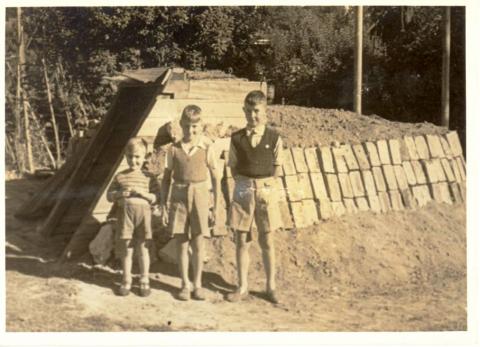CHILDHOOD REFLECTIONS – 10 Years in YALLOURN from 1932 to 1942
Our move to Yallourn in 1932, soon after I was born, followed dad’s appointment as Principal of Yallourn Tech. when the school consisted of three small timber cottages in Narracan Avenue and had only three other full time teaching staff. The family lived initially in Ridgeway West, moving in 1934 to live at 29 Latrobe Avenue on the corner of Reservoir Road. My only memory of Ridgeway West was time spent in a pale blue fish-shaped rocking horse on the back veranda. Another early recollection of life in Yallourn was the nightly routine of Mum tucking me in for the night and saying as she did “see you when the whistle blows”. We had moved to Latrobe Avenue when, at age 4½, I commenced at Yallourn Primary School, where teachers in the lower grades included Miss Shorten, Win Tinkler and Honour Gloss. Mr Edmondson, one of the most effective teachers I have experienced, taught both grades 5 and 6 in the High School building. He managed very well without any of the teaching aids now regarded as essential.
At about age six I had my tonsils removed by Doctor Andrew at the Yallourn Hospital, a common procedure in those days. Chloroform was the anaesthetic of choice, inhaled from a pad placed over the patient’s nose and trivial conversation was used by the doctor to encourage inhalation! I remember being told that I could have as much ice cream as I could eat after the operation. What he didn’t tell me was that I wouldn’t feel like ice cream or anything else much for quite a few days - doubtful whether the pain was worth the reward offered. I also remember when recuperating at home that I could look out of my bedroom window and see the swing dad had built in our yard, hanging from the large wattle trees that I loved to climb. There was also the slanting rail on the post-and-wire fence between our back yard and Newman’s, from which I managed to slip and break my right arm when quite young. Empire Day and Guy Fawkes Day were both occasions to celebrate in our back yard with a variety of fireworks, Catherine wheels, skyrockets and crackers.
Practical gardening sessions conducted at the SEC Nursery by the head nurseryman, Mr Lawson, were a regular feature of the Grade six program. This school activity was years ahead of latter-day gardening educators with their respective radio and TV programs and was highly effective as the classes created an interest in gardening. We learnt about soils, pruning, how to strike cuttings and propagate seeds. Another memory of the early years of school was the series of ‘Readers’, a new one each year, and the ‘School Paper’ that came at regular intervals.
A severe epidemic of infantile paralysis (polio) reached Yallourn in 1937 causing the school year to be cut short and the 1938 start to be deferred until March. A further tragedy affected Yallourn on 13 January 1939, later known as ‘Black Friday’; much of Gippsland was ravaged by disastrous bush fires when temperatures reached 118°F (48°C). As a member of the Yallourn Civic Association, dad assisted in providing practical assistance to a number of needy communities. I was only seven years old at the time and recall travelling with dad as far afield as Noojee and Walhalla delivering household essentials such as pots & pans, blankets etc to families who had lost everything in the fires.
In 1938 the SEC found a larger house for our expanding family (John was born in 1935 and David in 1938) at 26 Hillside, a solid brick house vacated when the McMahons moved to Melbourne. The effect of WWII was starting to be felt in the community as I neared the end of primary schooling - students were raising funds for the war effort and I received a very large coloured Education Department Certificate, complete with a gold embossed Department of Education seal, dated July 1941 and headed ‘Young Workers’ Patriotic Guild’ to show that, as a student of Yallourn School 4085, I raised £1 for “War Relief objectives”. The full effect of wartime restrictions – food, petrol and clothing rationing, blackout (curtains, outside lights and car headlamps) and gas producers for cars – was felt and many mothers and children left Yallourn for safer places. We built a rather large air raid shelter in the back yard as many others did at the time – its floor level was about three to four feet below ground level and excavated soil was thrown over the shelter for added protection. It was about 12 feet long by 4 feet wide, had seats and was fitted with a hand operated drainage pump. In 1942 I left Yallourn briefly to live with my Grandfather in Ballarat commencing in Form 1 at the Technical School but moved back to Yallourn to complete the year at Yallourn Tech. Staff at the time included Messrs Cain, Ford, Hansen, Hewitt, Jones, Lawson, Lundy, Robertson and Tyrell. An Army Camp on the Yallourn sports grounds with anti-aircraft guns and searchlights was further evidence that we were at war.
The Terrill and Johnson families both lived in Hillside, quite close to us and I spent lots of happy hours playing with Neil Terrill and Brian Johnson exploring the bush above our homes and in the railway cutting nearby, which was a good source of tadpoles for the fishpond at 26 Hillside.
Home remedies that were in common use in these years were a hot salt gargle for sore throats, inhalation of steam from Friar’s Balsam mixed in boiling water (with a towel over ones head) for head colds and acriflavine for the inevitable grazes, cuts and scratches. If we were considered to be below par a tonic was prescribed and Saunders malt extract, taken in large quantities from a desert spoon, was the more palatable alternative to a honey and sulphur mixture. Hot poultices were used to extract infected splinters and other foreign bodies.
Annual Sunday School Picnics were a very big event for the Yallourn Methodist Sunday School, travelling as we did by furniture van, to picnic spots on the Latrobe and other Gippsland Rivers at Narracan, Yinnar South, and Mirboo North etc for races, sandwiches, raspberry vinegar and lots of fun! The furniture vans had a row of seating down each side and windows as a concession to the role of carrying passengers, most of whom had an uncomfortable and unsafe ride standing between the seats.
Church activities included a boy’s club and youth choir, however, my time playing soccer with the Methodist Church’s junior team came to a sudden end when I stayed out, or was kept out, very late one night by an over-enthusiastic new coach discussing experiences from his career playing soccer in England. His long and detailed discussion of soccer strategy and game plans was mostly wasted on us juniors and certainly not appreciated by our parents. It was well after dark when distraught parents finally found us and I arrived home to Mum’s tears and a not-to-be-forgotten talking to.
I was quite often sent to the shops in the centre of the town to buy a loaf of bread - quarter or a half loaf for six pence or a shilling respectively. Located in the town centre shops was a newsagent, hairdresser, post office, general store, chemist (Miss Rose), dentist, doctor, a branch of the State Savings bank, an old fashioned grocery store and an ultra modern Civic Theatre where we often spent Saturday afternoons watching a variety of thrillers, Movietone newsreels, trailers, shorts, cartoons (of the Mickey Mouse, Popeye, Felix variety) and cowboy-and-Indians type films, all for sixpence. Attending my first full-length feature film at night, Snow White and the Seven Dwarfs (or was it Fantasia?) was a rather special event.
Graham Beanland
March 2012
26 Hillside - Beanland Family
Beanland brothers - David, John & Graham - in front of air-raid shelter at 26 Hillside in 1947.


Wow I have never seen any of
Wow I have never seen any of the photos of the backyard air raid shelters in Yallourn. Any photos of what the inside looked like??? Long's in Railway Avnue had one but it was pulled apart and only the ground brick work remained - think it was fillled in I am not sure - we were never allowed to explore it. The only other ones I had seen was up the back of the scout hall where I lost my shoe in the dark.